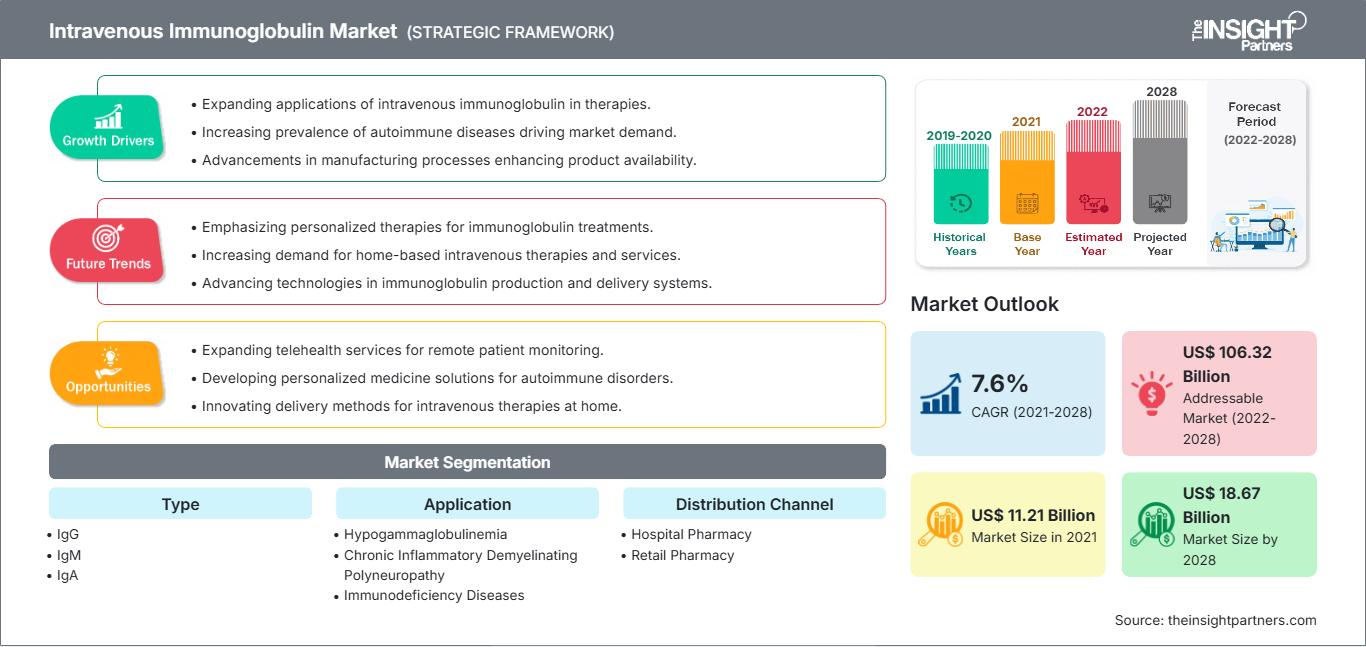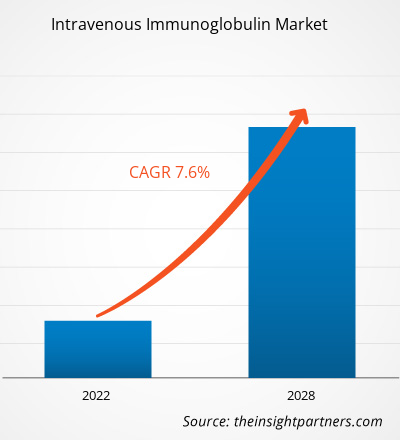Le marché des immunoglobulines intraveineuses était évalué à 11 206,54 millions de dollars américains en 2021 et devrait atteindre 18 672,55 millions de dollars américains d'ici 2028 ; sa croissance devrait atteindre un TCAC de 7,6 % entre 2022 et 2028.
Les immunoglobulines sont des anticorps produits naturellement par le système immunitaire de l'organisme, qui aident à combattre les infections et les maladies. Le déficit en immunoglobulines nécessite l'administration externe d'immunoglobulines et est connu sous le nom de thérapie de remplacement des immunoglobulines (IgRT). L'IgRT peut être administrée par voie intraveineuse et sous-cutanée. Les immunoglobulines intraveineuses (IgIV) et sous-cutanées (IgSC) sont sélectionnées en fonction de l'indication et de la gravité. Les IgIV sont fabriquées à partir de plasma humain. Il contient des anticorps et est utilisé pour traiter un nombre croissant de maladies immunologiques, hématologiques et neurologiques.
Le marché des immunoglobulines intraveineuses est segmenté par type, application, canal de distribution, utilisateur final et zone géographique. Par zone géographique, le marché est largement segmenté en Amérique du Nord, Europe, Asie-Pacifique, Moyen-Orient et Afrique, et Amérique du Sud et centrale. Ce rapport offre un aperçu et une analyse approfondie du marché, en mettant l'accent sur des paramètres tels que les tendances et la dynamique du marché, ainsi que sur l'analyse concurrentielle des principaux acteurs mondiaux.
Personnalisez ce rapport en fonction de vos besoins
Vous bénéficierez d’une personnalisation sur n’importe quel rapport - gratuitement - y compris des parties de ce rapport, ou une analyse au niveau du pays, un pack de données Excel, ainsi que de profiter d’offres exceptionnelles et de réductions pour les start-ups et les universités
Marché des immunoglobulines intraveineuses: Perspectives stratégiques

- Obtenez les principales tendances clés du marché de ce rapport.Cet échantillon GRATUIT comprendra une analyse de données, allant des tendances du marché aux estimations et prévisions.
Vous bénéficierez d’une personnalisation sur n’importe quel rapport - gratuitement - y compris des parties de ce rapport, ou une analyse au niveau du pays, un pack de données Excel, ainsi que de profiter d’offres exceptionnelles et de réductions pour les start-ups et les universités
Marché des immunoglobulines intraveineuses: Perspectives stratégiques

- Obtenez les principales tendances clés du marché de ce rapport.Cet échantillon GRATUIT comprendra une analyse de données, allant des tendances du marché aux estimations et prévisions.
Aperçu du marché
La prévalence croissante des maladies d'immunodéficience et l'augmentation de la population gériatrique stimulent le marché des immunoglobulines intraveineuses.
Selon l'Institut national des allergies et des maladies infectieuses (NIAID), plus de 200 types différents de déficits immunitaires primaires (DIPP) touchent environ 500 000 personnes aux États-Unis. Ces maladies génétiques rares peuvent être chroniques, faibles et coûteuses. La thrombopénie immunitaire (PTI) est une maladie hémorragique auto-immune caractérisée par des taux anormalement bas de plaquettes ; une situation appelée thrombopénie. Selon l'Organisation des maladies rares, environ 200 000 cas de PTI sont enregistrés chaque année dans le monde. De plus, selon la Division de la population des Nations Unies, Perspectives de la population mondiale 2019, les pays asiatiques et européens comptent certaines des populations les plus âgées au monde, âgées de 65 ans et plus. Le Japon arrive en tête avec 28 %, suivi de l'Italie avec 23 %. De plus, la Finlande, le Portugal et la Grèce figurent parmi les cinq premiers pays avec une population âgée de moins de 22 %. De nombreux patients traités par IgIV ont plus de 60 ans. Avec l'âge, la capacité à produire des lymphocytes T pour combattre les maladies diminue considérablement. Ainsi, l'organisme d'une personne âgée est facilement sujet à plusieurs infections et maladies, ce qui augmente la demande de thérapies immunitaires impliquant l'utilisation d'IgIV. Ainsi, l'augmentation des maladies d'immunodéficience et l'augmentation de la population gériatrique à travers le monde renforcent le marché des immunoglobulines intraveineuses.
Informations basées sur le type
En fonction du type, le marché des immunoglobulines intraveineuses est segmenté en IgG, IgM, IgA, IgE et IgD. Français Le segment des immunoglobulines de type IgG détenait la plus grande part de marché en 2021. Cependant, le segment des appareils portables devrait enregistrer le TCAC le plus élevé au cours de la période de prévision en raison de sa large application des IgG dans le traitement de plusieurs catégories de troubles.
Aperçus basés sur les applications
En fonction des applications, le marché des immunoglobulines intraveineuses est segmenté en hypogammaglobulinémie, polyneuropathie démyélinisante inflammatoire chronique, maladies d'immunodéficience, myasthénie grave, neuropathie motrice multifocale, purpura thrombocytopénique idiopathique, myopathies inflammatoires, déficit en anticorps spécifiques, syndrome de Guillain-Barré, etc. En 2021, le segment des maladies d'immunodéficience détenait la plus grande part de marché. De plus, ce même segment devrait connaître une croissance de la demande au TCAC le plus rapide entre 2022 et 2028, en raison de la prévalence croissante des maladies d'immunodéficience et de l'augmentation des approbations par la FDA des produits d'immunoglobulines intraveineuses pour le traitement de l'immunodéficience.
Informations basées sur les canaux de distribution
Selon les canaux de distribution, le marché des immunoglobulines intraveineuses est segmenté en pharmacies hospitalières, pharmacies de détail et autres. En 2021, le segment des pharmacies hospitalières détenait la plus grande part de marché. Français De plus, le segment des pharmacies de détail devrait connaître une croissance de sa demande au TCAC le plus rapide entre 2022 et 2028, en raison de l'expansion des pharmacies de détail et de l'évolution du comportement des consommateurs vers des pharmacies de détail organisées qui proposent des médicaments et des médicaments de haute qualité.
Informations basées sur l'utilisateur final
En fonction de l'utilisateur final, le marché des immunoglobulines intraveineuses est segmenté en hôpitaux, cliniques spécialisées et autres. En 2021, le segment des hôpitaux détenait la plus grande part de marché. De plus, le segment des cliniques spécialisées devrait connaître une croissance de la demande au TCAC le plus rapide entre 2022 et 2028, en raison des progrès réalisés par les cliniques spécialisées pour offrir une IgRT rapide et précise aux patients.
Les développements organiques tels que les approbations de produits sont des stratégies largement adoptées par les acteurs du marché mondial des immunoglobulines intraveineuses. Voici quelques-uns des développements clés récents du marché :
- En mars 2022, ADMA Biologics, Inc. a annoncé l’approbation de la Food and Drug Administration (FDA) des États-Unis pour prolonger la date d’expiration de 24 à 36 mois pour ses immunoglobulines (« IG ») ASCENIV et BIVIGAM stockées entre 2 et 8 °C. La prolongation de la date d’expiration s’applique à tous les lots existants d’ASCENIV et de BIVIGAM actuellement dans la chaîne d’approvisionnement commerciale, ainsi qu’à la production future d’ASCENIV et de BIVIGAM dans toutes les tailles de flacons, à toutes les échelles de production, ainsi qu’aux produits médicamenteux finis à remplissage interne et externe.
- En juin 2021, Octapharma a annoncé qu’Octagam 10 %, une immunoglobuline intraveineuse (IgIV) dérivée du plasma humain, a récemment reçu l’approbation de l’Union européenne (UE) en tant que traitement immunomodulateur pour les adultes atteints de dermatomyosite. Suite à l'approbation de l'UE, l'octagam 10 % a reçu l'approbation nationale en Allemagne le 11 mai 2021, et l'approbation dans d'autres États membres européens est attendue prochainement.
- En avril 2021, ADMA Biologics, Inc. a annoncé que la Food and Drug Administration (FDA) des États-Unis avait approuvé le processus de fabrication étendu de la société, permettant le fractionnement et la purification d'un pool de plasma de 4 400 litres pour la fabrication d'immunoglobulines intraveineuses (IVIG).
- En février 2020, CSL Behring a annoncé que la Food and Drug Administration (FDA) des États-Unis avait accordé à Privigen (immunoglobuline intraveineuse (humaine), liquide à 10 %) la désignation de médicament orphelin en tant que thérapie expérimentale dans le traitement de la sclérodermie systémique (SSc).
De tels développements par les acteurs du marché stimulent l'intraveineuse Marché des immunoglobulines.
Aperçu régional du marché des immunoglobulines intraveineuses
Les tendances régionales et les facteurs influençant le marché des immunoglobulines intraveineuses tout au long de la période de prévision ont été analysés en détail par les analystes de The Insight Partners. Cette section aborde également les segments et la géographie du marché des immunoglobulines intraveineuses en Amérique du Nord, en Europe, en Asie-Pacifique, au Moyen-Orient et en Afrique, ainsi qu'en Amérique du Sud et en Amérique centrale.
Portée du rapport sur le marché des immunoglobulines intraveineuses
| Attribut de rapport | Détails |
|---|---|
| Taille du marché en 2021 | US$ 11.21 Billion |
| Taille du marché par 2028 | US$ 18.67 Billion |
| TCAC mondial (2021 - 2028) | 7.6% |
| Données historiques | 2019-2020 |
| Période de prévision | 2022-2028 |
| Segments couverts |
By Type
|
| Régions et pays couverts | Amérique du Nord
|
| Leaders du marché et profils d'entreprises clés |
|
Densité des acteurs du marché des immunoglobulines intraveineuses : comprendre son impact sur la dynamique commerciale
Le marché des immunoglobulines intraveineuses connaît une croissance rapide, portée par une demande croissante des utilisateurs finaux, due à des facteurs tels que l'évolution des préférences des consommateurs, les avancées technologiques et une meilleure connaissance des avantages du produit. Face à cette demande croissante, les entreprises élargissent leur offre, innovent pour répondre aux besoins des consommateurs et capitalisent sur les nouvelles tendances, ce qui alimente la croissance du marché.

- Obtenez le Marché des immunoglobulines intraveineuses Aperçu des principaux acteurs clés
- Analyse historique (2 ans), année de base, prévision (7 ans) avec TCAC
- Analyse PEST et SWOT
- Taille du marché Valeur / Volume - Mondial, Régional, Pays
- Industrie et paysage concurrentiel
- Ensemble de données Excel
Rapports récents
Témoignages
Raison d'acheter
- Prise de décision éclairée
- Compréhension de la dynamique du marché
- Analyse concurrentielle
- Connaissances clients
- Prévisions de marché
- Atténuation des risques
- Planification stratégique
- Justification des investissements
- Identification des marchés émergents
- Amélioration des stratégies marketing
- Amélioration de l'efficacité opérationnelle
- Alignement sur les tendances réglementaires




















 Obtenez un échantillon gratuit pour - Marché des immunoglobulines intraveineuses
Obtenez un échantillon gratuit pour - Marché des immunoglobulines intraveineuses